Making AutoText Work for You
|
| < Day Day Up > |
|
Although AutoCorrect and AutoText can be used in similar ways—cutting down the time and effort you spend entering text—AutoText really has a different function. Instead of catching errors in spelling, capitalization, and spacing, the focus of AutoText is simply to help you enter text as quickly as possible. AutoText works with the AutoComplete feature to anticipate the words you are preparing to enter and to insert them for you. By spending the time to educate Word about the terms, phrases, and descriptions often used in your documents, you can both save text entry time and reduce your margin for error.
Inserting AutoText Entries
AutoText gives you a long list of entries to choose from, including standard elements of documents such as the attention line, mailing instructions, company name, salutations, e-mail options (which include a complete list of the e-mail addresses Word recognizes from your Outlook Contacts list), and a Person selection, which lists the names of the individuals in your Address Book.
You begin the process of using AutoText by choosing Insert, AutoText. A menu of AutoText choices appears, and you can point to a selection to display specific AutoText choices, as shown in Figure 7-17.
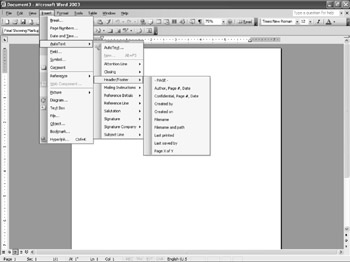
Figure 7-17: AutoText uses the text you often add and the text you've already entered to create the fastest means of text entry for your documents.
When you want to add AutoText to a header or footer in your document, start by displaying the Header And Footer toolbar by choosing View, Header And Footer. Then click in the header (or footer) and follow these steps:
-
Choose Insert, AutoText. A list of Header and Footer AutoText items appears.
-
Choose the item you want to add as AutoText. The text is added at the insertion point.
You'll notice that although the AutoText menu choice appears as, for example, Author, Page #, Date once the AutoText is inserted in the document, the actual data appears—your name, the current page number, today's date. The Header and Footer AutoText entries are actually field codes, meaning that they are replaced with data when they are used in the document. Every time you open a document, these fields will be updated as needed.
Inserting AutoText in Your Document
AutoText is enabled by default. When you begin typing a word or phrase AutoText recognizes, it displays the rest of the phrase in a ScreenTip above the word you are typing, with the instruction "(Press ENTER to Insert)," as shown in Figure 7-18.
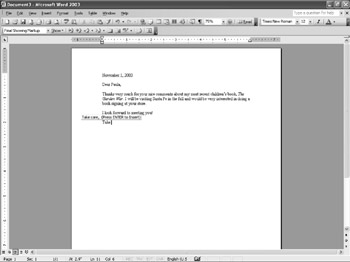
Figure 7-18: AutoComplete offers to complete a word or phrase for you. Press Enter to add the text as prompted.
| Tip | If AutoText doesn't come to your rescue when you begin typing a phrase it should recognize, make sure AutoComplete is enabled by choosing Tools, AutoCorrect Options, and then clicking the AutoText tab. The first check box, Show AutoComplete Suggestions, should be selected. If it isn't, check the box, and then click OK to save your changes. Now AutoText should work as expected. |
Although entering AutoText on the fly, as you're prompted, offers the fastest way of inserting AutoText entries, you can add entries from the AutoText tab in the AutoCorrect dialog box if you choose. Simply scroll through the AutoText entry list box until you find the item you want, click it, and then click Insert. Word adds the text you selected at the insertion point in your document.
Inside Out: Comparing AutoText and AutoComplete
Confused about the difference between AutoComplete and AutoText? The two terms are actually two parts of the same process. AutoText entries are the words and phrases you enter by choosing the AutoText selection from the Insert menu. AutoComplete is the process of finishing a partially typed word or phrase for you. But when you want to enter new phrases for AutoComplete, where do you go? To the AutoText tab in the AutoCorrect dialog box.
Adding Your Own AutoText Entries
What other entries will AutoText insert for you? Months, days of the week, and names it recognizes. The best way to get the full effect of AutoText, however, is to teach it to enter the words and phrases you use most often. This is really a simple thing to do.
The quickest way to add AutoText entries is just to type your document. When you get to a word or phrase that you'd like to enter as AutoText, select it, and then press Alt+F3. The Create AutoText dialog box appears, as shown in Figure 7-19, and all you need to do is click OK. The phrase is added to your list and will be suggested for insertion the next time Word recognizes that you're beginning to type it.
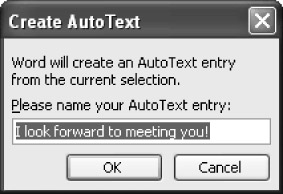
Figure 7-19: Fast and simple—add an AutoText entry by selecting the phrase and pressing Alt+F3.
| Note | You can also add AutoText entries in the AutoText tab in the AutoCorrect dialog box. Simply type the entry in the Enter AutoText Entries Here box, and then click Add. Using this method is best when you have several entries to create. When you're finished adding entries, click OK to return to your document. |
Managing AutoText Entries
You've already spent some time in the AutoCorrect dialog box, which includes a tab for AutoText. Here you have another way to add your own AutoText entries. You can also manage the entries you have by inserting and deleting them. Figure 7-20 shows the AutoText tab in the AutoCorrect dialog box.
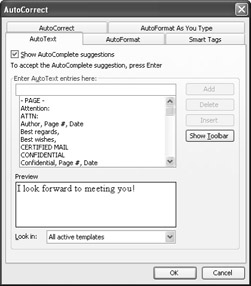
Figure 7-20: You can manage the AutoText entries you add and insert in the AutoText tab in the AutoCorrect dialog box.
Disabling AutoText
If AutoText just gets under your skin and you want to disable the feature (but why?), you can do so easily by displaying the AutoCorrect dialog box (choose Tools, AutoCorrect Options), clicking the AutoText tab, and then clearing the Show AutoComplete Suggestions check box. That suppresses the display of the AutoText ScreenTips that come to your rescue as you type. When and if you want to use AutoText again, simply repeat the steps and select Show AutoComplete Suggestions check box.
| Tip | Improve speed by disabling AutoText Some users feel that ScreenTips slow Word down, especially in large documents and documents that are heavily loaded with graphics. If you find this to be true on your system, try disabling AutoText to see whether the change makes a difference in performance. |
Choosing Templates for AutoText
By default, AutoText looks in all active templates to find the AutoCorrect entries used in your document. The items you add are saved in Normal.dot, the global template Word traditionally uses for newly created files (unless you specify otherwise). To choose a different template, click the Look In arrow in the AutoText tab in the AutoCorrect dialog box, and then click the template you want to use.
Saving AutoText Entries to Other Templates
If you've added other templates to Word, you can save AutoText entries in them by following these steps:
-
Choose Tools, Templates And Add-Ins to display the Templates And Add-Ins dialog box.
-
Click Organizer, and then click the AutoText tab. The listing on the left shows the AutoText entries in Normal.dot, the global template. The listing on the right shows the AutoText entries in the current document. If you want to change the template from which you are copying the AutoText entries, click Close File on the left to close the selected file, and then click Open File and choose the file you want to use.
-
Select the AutoText entries in the left listing that you want to copy to the file on the right side of the Organizer dialog box, as shown in Figure 7-21. Click Copy. The AutoText entries are added to the template on the right.
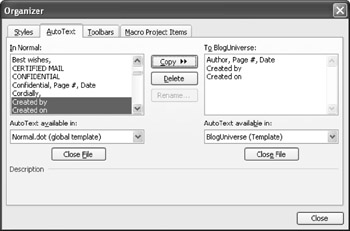
Figure 7-21: Copying AutoText entries to another document template is a simple matter when you use the Organizer available through Tools, Templates, And Add-Ins. -
Click Close to exit the Organizer dialog box and return to your document.
Tip Why copy AutoText entries? If AutoText is capable of looking in all available templates for possible entries, why is it necessary to copy entries from one template to another? If you're creating a standard template for your department or group, or you simply want a backup copy for yourself, having all the same AutoText entries saved in the template you use helps ensure consistency in the documents you create. It also can save your co-workers time, depending on how complete your AutoText entries are.
Using the AutoText Toolbar
Word includes an AutoText toolbar you can use to insert entries, add new words and phrases, and display the AutoText options. You can display the toolbar in one of two ways:
-
Choose View, Toolbars, and then click AutoText.
-
Click Show Toolbar in the AutoText tab in the AutoCorrect dialog box.
The AutoText toolbar is shown in Figure 7-22. You can use this toolbar to insert, create, and manage your AutoText entries.
![]()
Figure 7-22: The AutoText toolbar gives you tools for displaying the dialog box, inserting, and adding entries.
| Tip | List AutoText entries Want to see a complete list of all your AutoText entries? You can print a list from the Print dialog box. Press Ctrl+P to display the Print dialog box, choose your printing options, and, in the Print What list box, select AutoText Entries, and then click OK. A full listing of your AutoText entries will be printed. |
|
| < Day Day Up > |
|
EAN: 2147483647
Pages: 373
- Chapter I e-Search: A Conceptual Framework of Online Consumer Behavior
- Chapter II Information Search on the Internet: A Causal Model
- Chapter III Two Models of Online Patronage: Why Do Consumers Shop on the Internet?
- Chapter XVI Turning Web Surfers into Loyal Customers: Cognitive Lock-In Through Interface Design and Web Site Usability
- Chapter XVII Internet Markets and E-Loyalty